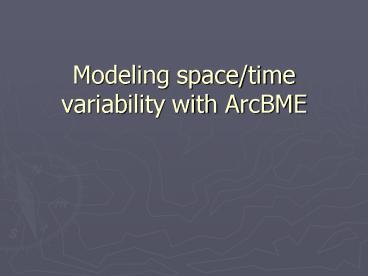Modeling spacetime variability with ArcBME PowerPoint PPT Presentation
1 / 19
Title: Modeling spacetime variability with ArcBME
1
Modeling space/time variability with ArcBME
2
Agenda
- Step by step instruction
- Screen4 Mean Trend Analysis Screen
- Screen5 Covariance Analysis Screen
- Back to previous screen
- About tgisini.py
3
Screen 4 Mean Trend Analysis
- Calculate Spatial/Temporal Mean Trend
4
Mean Trend Calculation
- Assume a separable additive space/time mean trend
model - Input Parameter
- Spatial Range/Spatial Radius
- Temporal Range/Temporal Radius
- Averaging the measurement at each MS.
- Find measurements within Sradius , then apply
exponential filter
5
Smoothed Mean Trend
6
Remove Mean Trend
- Removing the mean trend from data
Z - (SSMSTM-mean(STM))
Z Value SSM Smoothed Spatial Mean Trend STM
Smoothed Temporal Mean Trend
7
Calculate Mean Trend
- Click Model mean trend and remove it from data
8
Recalculate Mean Trend
- Input parameters and click Recalculate Mean
Trend - Spatial Radius/Spatial Range
- Temporal Radius/Temporal Range
Spatial Range
Spatial Radius
Click Button
Temporal Radius
Temporal Range
9
Create ArcGIS layer file
- Click Create Point Layer File
- Following files will be created
- spatial_(raw/sm)_mean(number).lyr
- spatial(raw/sm)mean(number).dbf/
spatial(raw/sm)mean(number).dbf.xml - Ex) spatial_sm_mean1.lyr
- spatial_raw_mean5.lyr
Click Button
10
Screen 5 Covariance Analysis
- Experimental Covariance
- Fit experimental covariance with model
11
Experimental Covariance
- Spatial Component
- Temporal Component
Spatial Component
Temporal Component
12
Change number of lags
- Input the number of lags, then click Recalculate
Spatial/Temporal Covariance
Recalculate Spatial Cov.
Number of lags for Spatial Cov.
Recalculate Temporal Cov.
Number of lags for Temporal Cov.
13
Modify lag and lag tolerance
- Click Edit Spatial/Temporal Lags
- Input lag and tolerance in dialog box, then click
OK
14
Covariance Model
- ArcBME supports
- homogeneous/stationary Space/Time random field
- Space/Time separable model
- Maximum four model structures
- Following covariance model
- exponential
- gaussian
- spherical
- holecos
- holesin
15
Set the number of model structures
- Set the number of model structures
- Input the number into text box
- Click Change Number of Structure
- The number of tabs will change
16
Select covariance model
- Select model from the combo box
- Input sill and range, then click Plot Model
17
Clear covariance model
- Plot Clear button
- Covariance model will be erased from the figures
18
Back to previous screen
- Click Back button
- If the parameters such as aggregation period, log
transformation method, or units, are changed,
dialog box will appear - All parameters and estimation results will be
deleted
19
About tgisini.py
- tgisini.py file stores default parameters of
ArcBME - progLocation entry is used to assign the
location of TGISGUI folder - Default value is H\\TGISGUI
Program file location Path to program file
location progLocation H\\TGISGUI'

